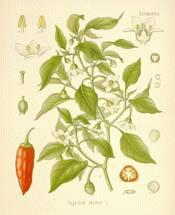
Botanical.com Home Page

|
Cayenne Pepper
(Capsicum annuum)
Click on graphic for larger image
|
Cayenne
Botanical: Capsicum minimum (ROXB.)
Family: N.O. Solanaceae
---Synonyms---African Pepper. Chillies. Bird Pepper.
---Part Used---Fruit, ripe and dried.
---Habitat---Zanzibar - but now grown in most tropical and sub-tropical countries.
---Description---Cayenne or Capsicum derives its name from the Greek, 'to bite,' in allusion to the hot pungent properties of the fruits and seeds. Cayenne pepper was introduced into Britain from India in 1548, and Gerard mentioned it as being cultivated in his time. The plant was described by Linnaeus under the name of C. frutescens proper. This species appeared in Miller's Garden Dictionary in 1771. It is a shrubby perennial plant 2 to 6 feet high. Branches angular, usually enlarged and slightly purple at the nodes; petioles medium; peduncles slender, often in pairs, and longer than the fruit; calyx cup-shaped, clasping base of fruit which is red, ovate, and long; seeds small and flat, from ten to twenty-nine. The cuticle of the pericarp is uniformly striated and in this particular is distinct from other species. Taste very pungent and smell characteristic. It is difficult to determine the source of true powdered Capsicum, as the colour is affected by light, so that it should always be kept in dark receptacles. African pepper is generally light brownish-yellow colour and very pungent; its pungency appears to depend on a principle called Capsicin. Cayenne is sometimes adulterated with oxide of red lead, which may be detected by digesting in dilute nitric acid. Other adulterants are coloured sawdust which can be found by the aid of the microscope. The British Pharmacopceia requires that capsicum should yield not more than 6 per cent of ash, and this test detects the presence of most adulterants.
---Constituents---Capsaicin, a red colouring matter, oleic, palmitic and stearic acids.
---Medicinal Action and Uses---A powerful local stimulant, with no narcotic effect largely used in hot climates as a condiment, and most useful in atony of the intestines and stomach. It should not be used in ordinary gastric catarrh. For persons addicted to drink it seems to be useful possibly by reducing the dilated blood-vessels and thus relieving chronic congestion. It is often added to tonics and is said to be unequalled for warding off diseases. Herbalists use it largely in pill form and powdered. Externally it is a strong rubefacient and acts gently with no danger of vesication; is applied as a cataplasm or as a liniment; it can be mixed with 10 to 20 per cent of cotton-seed oil. The powder or the tincture is beneficial for relaxed uvula. A preparation in use in the West Indies called Mandram, for weak digestion and loss of appetite, is made of thinly sliced and unskinned cucumbers, shallots, chives, or onions, lemon or lime juice, Madeira, and a few pods of bird pepper well mashed up in the liquids. It can be used as a chutney.
---Doses---For a gargle: 1/2 drachm of powder to 1 pint of boiling water, or 1/2 fluid ounce of the tincture to 8 fluid ounces of rose water. If the throat is very sensitive it can be given in pill form - generally made with 1 to 10 grains powder. The infusion is made with 2 drachms to 1/2 pint boiling water taken in 1/2 fluid ounce doses. The tincture is used as a paint for chilblains.
See PAPRIKA (listed as a synonym of Pepper, Hungarian).
[Top]
Common Name Index
A MODERN HERBAL Home Page
Bear in mind "A Modern Herbal" was written with the conventional wisdom of the early 1900's. This should be taken into account as some of the information may now be considered inaccurate, or not in accordance with modern medicine.
© Copyright Protected 1995-2024 Botanical.com
|

